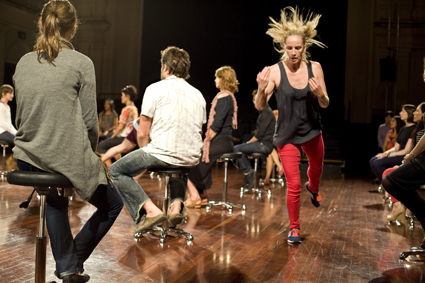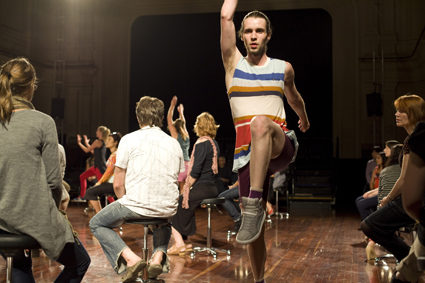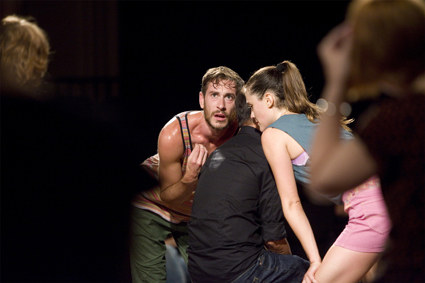dance massive 2013
March 27 2013
dance: installed, immersed, hybridised
keith gallasch: dance massive 2013
quotidian moves, gangnam-style
philipa rothfield: ben speth, wetubelive
dance massive 2013
sounds to dance to, with, against
gail priest: sound design in dance massive 2013
March 26 2013
the life in the work
philipa rothfield: tracie mitchell, dance screen retrospective
youtubing live
varia karipoff: ben speth, wetubelive
dance massive 2013
March 24 2013
dance & disorientation
keith gallasch: tim darbyshire, more or less concrete
more or less monstrous
jana perkovic: atlanta eke, monster body
realtime tv: tim darbyshire, more of less concrete, dance massive 2013
March 22 2013
ritual entwining
philipa rothfield: soo yeun you, [gu:t] [work-in-progress]
strange affliction: dance massive & transcendence
keith gallasch: jo lloyd, future perfect
March 21 2013
a not so private hearing
carl nilsson-polias: tim darbyshire, more or less concrete
realtime tv: antony hamilton, black projects 1& 2, dance massive 2013
something ends, something begins
virginia baxter: dance exchange, dance for the time being - southern exposure
dance massive 2013
the perfection of submission
varia karipoff: jo lloyd, future perfect
March 20 2013
inner fury, seductive skill
philipa rothfield: anouk van dijk, chunky move, 247 days
March 20 2013
old tropes & the new disconnect
carl nilsson-polias: lucy guerin inc & belvoir, conversation piece
March 19 2013
now, then, now
keith gallasch: sandra parker, the recording
realtime tv: anouk van dijk, 247 days, chunky move, dance massive 2013
dance massive 2013
March 18 2013
creating an affective community
jana perkovic: matthew day, intermission
fun and the damage done
keith gallasch: larissa mcgowan, skeleton
more than smoke and mirrors
virginia baxter: ashley dyer, life support
realtime tv: lee serle, p.o.v., dance massive 2013
March 17 2013
realtime tv: dalisa pigram, gudirr gudirr, dance massive 2013
the body un-mirrored
jana perkovic: anouk van dijk, chunky move, 247 days
the origins of feeling
philipa rothfield: sandra parker, the recording
March 16 2013
realtime tv: stephanie lake, dual, dance massive 2013
dance massive 2013
March 15 2013
a dance for dark times
virginia baxter: dalisa pigram, gudirr gudirr
brittle bones & internal electricity
carl nilsson-polias: larissa mcgowan, skeleton
in the thick of it
philipa rothfield: lee serle, p.o.v.
March 15 2013
inside the audience
jana perkovic: lee serle, p.o.v
the poetry of pain
keith gallasch: stephanie lake, dual
dance massive 2013
when two become one
varia karipoff: stephanie lake, dual
March 14 2013
blacker than black
keith gallasch: antony hamilton, black projects 1 & 2
life in a puff
carl nilsson-polias: ashley dyer, life support
March 13 2013
dark symmetries
carl nilsson-polias: antony hamilton, black projects 1 & 2
lines of flight
philipa rothfield: dalisa pigram, gudirr gudirr
dance massive 2013
suggestive formalism
jana perkovic: natalie abbott, physical fractals
unsettling the audience
varia karipoff: natalie abbott, physical fractals
February 22 2013
an intense manifestation of dance
philipa rothfield: dance massive 2013, melbourne
dance massive 2013: from the archive
lucy guerin inc, conversation piece; antony hamilton, black project; atlanta eke, this monster body; matthew day, intermission; jo lloyd, future perfect; tim darbyshire, more or less concrete; natalie abbot, physical fractals; ben speth, wetubelive
 |
Kristy Ayre, P.O.V, Lee Serle
photo Ponch Hawkes |
P.O.V., IS, FOR THE MOST PART, VERY SATISFYING TO WATCH. SERLE —ONE OF THOSE DANCERS MELBOURNE KNOWS WELL FROM REGULAR APPEARANCES AT NEXT WAVE AND IN THE WORKS OF LUCY GUERIN INC AND CHUNKY MOVE—DEVELOPED P.O.V IN NEW YORK UNDER THE MENTORSHIP OF TRISHA BROWN, AS A PART OF THE ROLEX MENTOR AND PROTEGE ARTS INITIATIVE.
I have a personal liking for New York contemporary: I adore its rigorous, yet unpretentious simplicity. Across the board, it possesses a humility and matter-of-factness that are equally disarming in Europe and in Australia, and it is somehow able to withstand a cynical as well as a philistine eye. By whittling away all ornament, but never getting too bogged down in illustrating esoteric texts (as has happened in Europe), it is as if the American dancers never quite bush-bashed their way through tradition all the way into a settled, comfortable arrogance, but remained suspended in a state of focused, ambitious play. This approach appears in Melbourne dance in visible traces, through echoes of training and influence, in the works of BalletLab and Luke George. Unavoidably, P.O.V. too has arrived back from the US seeped in Trisha Brown’s aesthetic and ethic, clearly as the work of a young artist shaped heavily by a master builder.
 |
James Andrews, P.O.V, Lee Serle
photo Ponch Hawkes |
Serle seats (some of) the audience on 36 swivel stools that dot the stage in orderly intervals. Four dancers—Serle, Lily Paskas, Kristy Ayre, James Andrews—travel between them, through the grid of aisles. It becomes immediately clear that where you sit will determine your experience—I felt a none-too-subtle nudge in my semiotic ribs—and, having arrived too late for a coveted stage seat, I perched on top of the seating bank, getting a nice, rounded overview of the piece. (It is to the show’s credit that every reviewer of P.O.V. so far has specified where they sat.)
There are three distinct parts to the choreography. In the first, the four dancers traverse the space between people in an orderly formation, performing a mesmerising score—very Brown—of simple, pendular movements that gently roll their weight up and down the aisles. At times, the choreography looks like tightly stitched-together pieces of athletic sports, with segments of continuous movement blending into one another in surprising ways: the momentum-building squat of a distance runner morphs into the swirl of the discus or javelin thrower, or into the oblique leap of a high jumper. Sequences keep unfolding instead of halting and turning, the dancers’ formation growing in mathematical complexity, while the spectators swivel their chairs to watch. It looks like the patterns of pedestrians in a city; it also looks like a complex collage of film footage from Olympics documentaries and newsreels. It is utterly beautiful in the way of abstract flows.
 |
Lee Serle, Lily Paskas, P.O.V
photo Ponch Hawkes |
In the second part, the dancers step out of performer aloofness and approach the audience members, increasingly intrusively. Some are stared at, some get a surprise massage, one is briefly blindfolded, another has her feet washed, one is shown something on a tablet, some are taken offstage, one is given wine and a chat with all of the dancers. Ayre gives a set of headphones to a woman, takes another set, and performs a little private dance (funny, almost like a parody of a lap dance) to the music only they can hear. Serle repeats this with another audience member, but his dance involves a great deal of animal poses. Paskas stretches herself gently over a man. As audience interaction, this is not so much about letting other people into the performance—there is no ceding of control, ever—as it is about multiplying, unweaving the energy lines between the stage and the audience. The main effect is not for a multitude of spectators to have a meaningful individual experience (they do not), but to complicate the audience focus from a straight phalanx of one-way looks to a knot, a jumble of sight lines with different levels of energy, stress, comfort, feeling of inclusion or exclusion, and amusement.
The second part is in some ways the weakest, because it relies on trivial tropes of audience engagement: singing to them, touching them slightly awkwardly, as well as having conversations designed only to look like conversations from far away. It takes part three to demonstrate that something more has been achieved. The dancers return to their dance, their path through the swivel-stool grid now circular, simplified. Their movements have become smaller, gentler, introverted—and also more twee, wristy: more Lucy Guerin than Trisha Brown—but the most noticeable shift is in how our attention has softened. The barriers separating the dancers from the audience have glaringly thinned, the energy in the room is completely different. Like a street after an incident—a burst pipe, a found pet—has made us all talk to each other.
P.O.V. is clearly an apprentice’s graduating piece. The title sums up its exploratory horizons, and it reproduces Brown’s body language without showing how Serle is a creative mind of his own. Where it deviates, it pulls back in the influences and mannerisms of Obarzanek and Guerin, and chooses easy paths, such as humorous tropes. However, for as long as it is able to resist its own striving to busy itself up with features, for as long as it can stay disciplined and clear-headed, P.O.V. is immensely satisfying.
Dance Massive, Arts House: P.O.V. director, choreographer Lee Serle, performers, collaborators James Andrews, Kristy Ayre, Lily Paskas, Lee Serle, lighting Ben Cisterne, composition, sound design Luke Smiles, set design Lee Serle, costumes Lee Serle, Shio Otani in collaboration with the performers; production management Megafun, North Melbourne Town Hall, March 12-16; http://dancemassive.com.au/
© Jana Perkovic; for permission to reproduce apply to [email protected]
Back to top











 back
back